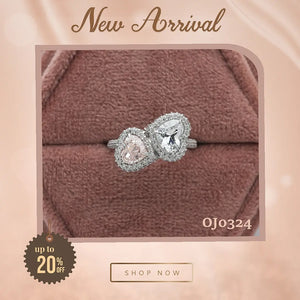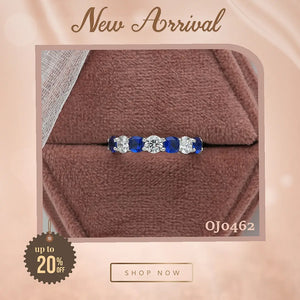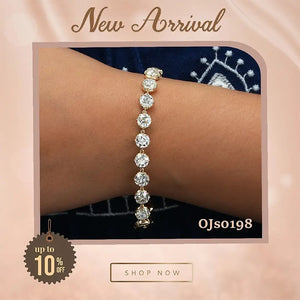4Cs of Diamonds - What You Can't Miss To Know and Understand

"Diamond 4Cs includes four factors: Carat Weight, Cut, Color, and Clarity. These four factors decide how much the sparkle will be reflected and in which shade the stone appearing in the jewelry will be recognized. This is the principle or rule for defining the diamond's sparkle, price, and appearance. GIA (Gemological Institute Of America) developed the concept of the 4Cs of Diamonds."
When customers purchase the diamond for the first time, they assume a price is based on carat weights, dimensions, and color grades. But it's a half-truth. A diamond cut and clarity also take a part in a decision on price and appearance. So, these four Cs work together, and they're interactly connected.
GIA accepts that lab-grown diamonds are alternative diamonds of mined gems due to identical optical, chemical, and faceting placements. Thus, whenever you love to have a pink oval-shaped diamond in a promise ring or like to choose a chocolate-colored princess cut diamond tennis bracelet, you must consider the best quality.
In addition, as you are purchasing diamond jewelry or loose diamonds for the first time, you're not familiar with lab diamonds and natural diamonds.
You might be curious to find a question: what is the difference between natural and lab-grown diamonds?
It's better to understand these differences because you purchase the diamond jewelry for your love commitment, not just for performing a task. So, the quality assurance is based on the better selection of 4Cs grades in diamonds.
As a result, if you shop for an engagement ring for women or get fancy-shaped diamonds for your wedding necklace, consider the best carat weight ranges and cut grades that allow you to experience true light reflections. The best 4cs guarantee you will share your personality's real and luminous appearance in diamond jewelry as the moon distributes its brilliance on cold nights.
Table of contents
What are the 4C's of diamonds?
The comprehensive concept of the 4Cs of diamonds was developed by GIA (Gemological Institute of America). However, the endeavor of professional evaluation of diamond jewelry according to these 4Cs grades was started in the 1940s by Robert M. Shipley, it is mentioned in the GIA's official blog post. He was the founder of GIA, and his professionalizing effort to set a benchmark of diamond scrutiny was accepted worldwide.
Still, most diamond markets use a 4Cs grade evaluation in every diamond shape, like an emerald or oval cut diamond. Also, the lab diamonds are interpreted as real diamonds, and their 4Cs are identical in accordance with carat weights, cut, color, and clarity.
With the diamond 4Cs, the evaluation becomes very easy for everyone, even for first-time buyers who don't know the hard terms about diamonds. GIA's 4cs of diamonds are recognized worldwide, and all diamond jewelry stores adopt that principle for deciding the final prices.
All of the four Cs contribute unique aspects to the diamond. A carat weight defines how big a gem will appear (it can be customized through dimensions). A cut has five grades, and it decides from the girdle thickness that is important for a reflection. In which color the diamond will offer a brilliance, depends on color grade. If a diamond contains blemishes or inclusions, that comes from the clarity.
But you still wondering why 4Cs are so important?
To clear this doubt, let's take an example.
If you want to shop a 1.00-carat brilliant round diamond solitaire ring in VVS clarity and E color, it's available between $700 and $2000. This is the price of a lab-grown diamond ring. If you would like to select a D-color diamond for your ring, you must increase the budget from $700 to $1500. Here, the color grade for a diamond is changed; thus, the cost varies, too.
But, if you like luxurious jewelry as your love sign, a natural diamond ring comes in the price range of $50K to $60K with the mentioned carat weights, cut, color, and clarity grades.
See any difference?
There are two differences: 1. Diamond types and 2. 4Cs grade variations.
Thus, with the help of 4C grades, anyone can shop for their favorite quality diamond jewelry while staying within the budget limit and appearance preferences.
So, when you opt for a princess cut engagement ring or an eternity wedding matching band for your wife in the diamonds, then you have to know every aspect of the 4Cs.
You can't ignore any of them for a beautiful look because all of them are interconnected; if you compromise on one grade, then the rest of those are definitely affected. Thus, make a wise decision on it and the best way to communicate a professional jewelers or stores, if you're a first time buyer.
Let's understand every C of diamonds in-depth so you can make a perfect decision and know why this principle still exists to decide the prices of diamonds and jewelry.
Diamond Carat Weights: A Size Factor

As you're a first-time buyer of diamonds, you first have to know "carat weights" because it connects with the size and appearance. As every material is measured in a particular unit, a diamond is measured in carats and grams. But diamonds are considered in the carat unit in the jewelry industry, where a 1 carat equals .20 grams of weight.
Meanwhile, some jewelers prefer to measure a diamond's weight in milligrams units to gather the correct dimensions and width. For example, a 1.00-carat round brilliant diamond equals 200 milligrams with a 6.49 MM width and 3.86 MM length. In addition, with personalization, the diamond can be customized to be shorter in length, wider in surface, and have a sharp-edged tick point without increasing the carats.
The range of diamond carat weights scales from 0.05 to +50.00; in between this, you can pick any weight per your jewelry style and preference. For example, if you have planned a surprise proposal for your love, choosing a 2 carat diamond ring will symbolize purity and an ideal connection. For a wedding diamond necklace, 20.00 carat weight will appear more appropriate.
Now you might have a question: what's the difference between diamond carat weight and size?
Carat weight refers to how much the diamond carries overall weight from the table surface to the ticking point and girdle to pavilion length with accommodation of crown heights. Conversely, a diamond size showcases the depth, width, length, and overall shape.
It's a fact that carat weight and size are on the same side of a single coin, and they're interchangeable. If you want to get a big appeared diamond, even without getting a much carat weight then you can benefit from the size customization. But the final appearance could vary from a diamond shape and craftsmanship level.
Ultimately, the cutting and polishing process is responsible for how much the diamond is made with the defined carat weights. In these processes, a rough diamond gets a final carat as a polished diamond like a 1.00 carat brilliant round cut diamond or 5.00 carat emerald diamond cut.
See the example to clarify the importance of a diamond carat's weight.
For example, suppose you're completing the 5th wedding anniversary at 14th February and your wife likes to have a bracelet, then a 10-carat weighted fancy color diamond bracelet is perfect present to give within the budget range $7000 to $10000.
But if your budget is only $5000, and you don't want to lose the 10-carat weight diamonds for bracelet jewelry, then you can still get it. You can choose a VS clarity and slightly different dimensions that seem identical to a $10000 diamond bracelet.
From this example, you can see how much a carat weight is important to complete your intention to wear highly sought-after luxurious jewelry without losing the expected appearance.
Diamond Cut Chart Grade: A Sparkle Reflection

The second C among the 4Cs for diamonds is a "cut grade." A cut grade has five types ranging from excellent to poor, where excellent is recommended and highly chosen, and poor cut is neglectable. From the girdle thickness and pavilion depth, a diamond gets a cut scale, and it's very important to acknowledge as you love a diamond's brilliance.
Diamond cut grade affects the price and appearance depending on the diamond shape. For example, round brilliant diamonds usually have excellent cuts, so they are priced at least $1000. For emerald diamonds, the cost decreases by around $800 with a very good cut grade. Thus, pick the perfect cut for the diamond according to the best appearance.
In which direction will the sparkle be reflected, and how quickly will it be retrieved from the table surfaces that depends on the cut grade selection and varies according to the elongated and square shape.
For example, a round brilliant diamond is known for its extraordinary light reflection, and it's mostly made with an excellent cut where the depth and girdle thickness remain thin. In addition, if you intend to pick this diamond shape for the Toi et Moi ring, then it's a good enough choice with the claw prongs and white gold.
While elongated shaped diamonds like emerald and radiant, the cut is also important to choosing between excellent to very good cut range because these diamonds don't have as much depth as the round cut does.
Thus, for a quick light reflection, the diamond cut should be selected wisely after confirmation with the professional jeweler. Also, you can take the help of your close friend or colleague who has some knowledge about it.
When a customer purchases a 1 carat diamond ring for $1500, they expect brilliance and shining reflection from it, but they can't experience it. Do you know why?
They compromise with the cut-grade quality and prioritize the budget. This is a common mistake that has occurred while purchasing diamond rings and jewelry styles. For example, a 1 carat round diamond is available for $1000 in excellent cut, but the customer finds a $700 priced good-cut diamond, and they often make mistakes here.
Also, the ring settings stop the diamond light reflection as you have opted for a bezel prong setting solitaire engagement ring or channel setting band for the wedding. Here, the backside of the diamond will be covered up by the metal creation on the ring, and you can't feel a glimpse of the brilliance. So, whenever you select a correct diamond cut grade, then pay attention to choosing the ring settings or other jewelry styles.
Diamond Color Grade: A Saturation Decider

A diamond color represents the originality and subsidiary shades saturation existing in the gems. According to GIA's color grade range, there are D (colorless) to Z+ (light yellow) for diamonds, and every diamond obtains a particular grade in accordance with its natural reflection.
If an Asscher cut diamond has a clear reflection without any other hues except an original white color, it's definitely a D color-grade diamond.
Whenever a heart shape looks slightly yellowish, but the amount of white natural reflection still appears in the diamond, then it's counted as a nearly colorless scale as in between G to J color grades.
So, it's understandable a diamond shape affects the color grade selection, and the personalized choice could be varied.
A D color diamond is colorless and free from any alternative shade on the surface. These diamonds are very rare to get; if they're available, they cost too much, somewhere around $15000 to $20000. With the brilliant cut diamonds like round and cushion shapes, it has been impossible to find. Also, some natural diamonds refer to blood diamonds, so the price is already given with a +500 - 700% hike.
Another side, Z+ color-grade diamonds are described as the light yellow category, which means a gem has a yellowish and sun rays reflection in the whole anatomy. These diamonds are not so rare to find, but they are still costly in natural diamonds.
Do you have some interesting facts related to the color grade of diamonds?
It might not.
You agree that every diamond has a color grade, and it's decided from its shade existence. But what for fancy color diamonds like blue, yellow, red, pink, or champagne?
So, these diamonds can be graded as Z+ color grade scale fancy-colored diamonds. The vivid color diamonds are not mentioned in the color grade chart, and you might be confused about them. In the GIA certification report, they individually graded for color scale and described particularly as blue diamond or black diamond.
As you understand the 4Cs of diamonds, a color grade is the backbone of the light reflection, and a cut grade is connected with it. So, you are shopping for a perfect diamond to get a better appearance, and it depends not only on picking the large carat weight and ideal cut grade but also on a color grade, which is also essential to consider.
Talking about the price perspective of highlighting the color grade, you need to know that it helps you set a realistic budget before purchase and decreases the risk of inconvenience.
For example, a D color-grade diamond costs much more than an I to J color diamond. If you want a slight yellowish hue on the diamond surface, then a K to M grade is acceptable, and its price is somewhere 20 - 50% cheaper than a D color.
Fancy colored diamonds have versatile options as per your choice: blue, pink, yellow, orange, black, olive, grey, red, golden, and chocolate diamonds. These diamonds are easily available in lab-grown types with an ethical manufacturing process and cheaper costs.
The most beneficial things about lab diamonds are that they are 100% authenticated and have real certification reports by GIA and other recognized diamond jewel institutions.
These vivid color diamonds can be selected for special jewelry presents according to their importance. For example, a tennis bracelet for women will be the best present to gift on Valentine's Day with multi-colored diamonds.
On the other hand, if you're making the grand moment for a wedding proposal, then see the list of colored diamond rings. From there, you can find the perfect match for what you're looking for.
Thus, considering the best color grade in diamond for your jewelry will be chosen with the perfection and expert consultation. It decides how your jewelry will appear and which colored reflection is counteracted depending on the color grade. So, as you prioritize to balance quality and budget, a color diamond grade should be scrutinized.
Diamond Clarity Grades: The Blemishes Notifier

According to GIA's clarity grade, there are 11 types of clarity. It decided from the blemishes and inclusions presence on the diamond's anatomy. As the last C of 4Cs diamonds, clarity is the most important factor for the perspective of cost and appearance. A diamond clarity works as the balance between the gem's quality, price, and look.
The 11 types of grades for diamond clarity range from Flawless (FL) to Included3 (I3). It describes how much the inclusions or blemishes cover the surface.
If the scratches on the diamond frequently have different patterns, it's counted as a low-clarity grade diamond. This clarity ranges on the chart from SI1 to I3, and it is mostly not selected due to its dull appearance. But a salt and pepper diamond ring is made with these grades.
It's acceptable whenever the inclusions or blemishes remain small or do not appear easily. Also, it's recommended grade for all kinds of jewelry styles, like a solitaire engagement ring for women. Like to gift a fancy chandelier earrings for bride, then it can be chosen, too.
The best clarity grade for a diamond is Flawless (FL) to Internally Flawless (IF). In this grade, the inclusions are unavailable and affect the natural light reflection. However, the price of this diamond clarity reaches $50K to $250K in naturally mined diamonds. The scarcity of these diamonds causes a high price tag. Also, the expert craftsmanship in the cutting and polishing process lifts the prices.
While moving towards cost-friendly clarity grades, then, no one can do better than a VVS (Very, Very Small Included 1/2). In this clarity, a diamond contains natural blemishes in small amounts that can't appear with the naked eye. However, with the 10X microscopic inspection, inclusions are noticed. In addition, the light reflection of these diamonds doesn't affect them anymore, like I3 clarity diamonds.
Thus, you can select a princess cut diamond and brilliant round diamond with this clarity for a halo engagement ring or hoop earrings whenever your budget can't exceed $2500.
Besides the round and princess diamond jewelry, you can mesmerize the proposal moment with the marquise engagement ring. With the VVS clarity diamonds, your marquise diamond cut ring looks finer and ideal if you properly measure the ring size at home and consider the proper carat weights, cut, and color grade.
We mentioned the list of 11 different clarity grades of the diamonds, which the GIA first developed.
| Abbreviation | Full Form | Identical Mark |
|---|---|---|
| FL | Flawless | Not a single blemishes containing. |
| IF | Internal Flawless | Free from the inclusions internally. |
| VVS1 | Very Very Small/Slightly Included1 | Some tiny scratches exists. |
| VVS2 | Very Very Small/Slightly Included2 | Little blemishes available on surfaces. |
| VS1 | Very Small/Slightly Included1 | Diamonds surface have some blemishes. |
| VS2 | Very Small/Slightly Included2 | The gouge appeared with blemishes. |
| SI1 | Small/Slightly Included1 | Excavate like inclusions appeares. |
| SI2 | Small/Slightly Included2 | Inclusions appeared in particular place. |
| I1 | Included1 | Diamonds have more inclusions on table. |
| I2 | Included2 | Additional scratches on crystal. |
| I3 | Included3 | Diamonds covered with inclusions with dull, milky appearance. |
The clarity of diamonds allows you to not compromise on your desired carat weight and color grade for your engagement and wedding jewelry. It helps you to pick the perfect quality and balance the cost with the favorite 4cs grades that you want to expect in jewelry.
Do you want brilliance or wish to spend less money? The average diamond clarity range used in jewelry is from VVS to VS. In this grade, the blemishes are absent in larger amounts and do not cost too much.
One of the most beneficial things about VVS diamonds is their versatility. They are suitable for a three-stone engagement ring or an eight-claw prong solitaire stud earring in rose gold. Also, every diamond shape looks prominent with these clarity grades, whether it's a bow-tie-affected oval diamond or a square-modified brilliant princess cut.
Thus, consider the best clarity grade for diamond jewelry even if you're confident about the purchase. It's best to discuss your clarity grade ideal range with a professional jeweler about the proper consultation. If you want to talk with us about this, you can freely do that; we will answer you.
Conclusion
Before the 4Cs of diamonds invention, the cost-deciding work was tougher even for expert diamond checkers and skilled, knowledgeable individuals. But after knowing the 4Cs grades as carat weights, cut, color, and clarity, this work is done easily, saving time for evaluation. As a result, when deciding the price and appearance, many jewelry stores follow the 4Cs chart that can help reveal the actual price.
Whenever you're shopping for diamond jewelry, whether for a promise ring or a wedding eternity band, you first decide the price range, like $1000 - $100K, as per your convenience. But, behind the price, you want to get a better quality, and it depends on the 4Cs of diamonds.
Besides the price point of view, you need the ideal appearance from that quality. So, for that kind of look, you have to pick proper carat weight ranges, perfect cut and color grades with clarity scales. Don't underestimate the importance of the cut grades. The perfect qualities vary from the jewelry styles and designs that you opted for, a gift or emblem of love and dedication.
For example, for a 1.00 carat unique engagement ring, you can select E color, VVS clarity, and Excellent cut grades. These grades are counted as the ideal qualities, defining a beautiful appearance in every attire, whether a daily outfit or a wedding gown.
So, when you're selecting a diamond ring or any of the jewelry styles, choose at least good quality grades that are able to give you the identical appearance that you expect. Also, pay attention to carat weights, color, and clarity grades.
Need more knowledge from our expert gemologists and diamond checkers? Click the button below and let us know which fact confuses you much more regarding the purchase or quality. So, we will consult you about anything related to diamonds and jewelry.
FAQ's
Let's understand some knowledge with quick answers and question sessions.
-
How are 4C diamonds determined?
The 4Cs of diamonds are determined from the GIA's cut, color, and clarity grades chart. This chart mentions every aspect related to the 4Cs grades evaluation. After its scrutiny, the actual grades are revealed, for example, as 3.00 carat weights D color grade round brilliant diamond with VS clarity and Excellent cut.
-
Does carat weight influence the diamond prices?
Yes, carat weights influence diamond prices, whether it's a lab-grown diamond or a precious mined stone. The dimensions are included in carat weights, and it shows the craftsmanship. So, it isn't easy to define a correct price according to carats. For example, a 1.00 carat diamond price remains at $70K to $150K, whereas a same grade 2.00 carat diamond cost reaches $250K.
-
Where are the 4Cs of diamonds described?
The 4Cs of diamonds are described in the certification report, where other dimensions like length, width, and depth are mentioned. GIA and IGI certification institutions authentically check the 4Cs grades according to their criteria and give in-written approval for the analysis. As a result, customers and buyers can understand whether they are paying the correct prices or not according to diamond quality.
-
Why choose excellent cut diamonds?
Excellent cut diamonds have more brilliance and refractive index than the remaining cut grades. As a result, customers prefer this cut-grade diamond, whether a typical round cut or a fancy marquise or oval-shaped diamond, for a constant brilliant reflection on the jewelry. Also, these cut diamonds are available in vivid colors like champagne, chocolate, red, and grey with diverse light reflections.
-
How color grade defines in diamonds?
Diamond's color grade is defined by the shade's intensity, reflection, and saturation appearance. For example, when brilliance, scintillation, and fire are released from diamonds in a natural white shade, they are colorless diamonds. While alternative shades like yellow, blue, and gray reflect from the diamonds, they refer to the fancy color diamonds.
-
What is the clarity grade in the 4Cs of diamonds?
Diamond clarity represents which part of the diamond is affected by the blemishes and inclusions and how much. It is an important part of the 4Cs of diamonds to decide whether the sparkle affects those scratches or not. The clarity for a diamond is graded from FL (Flawless) to I3 (Included3), as per the GIA's clarity chart.
-
How do the 4Cs of diamonds increase the jewelry's appearance?
Choosing the perfect carat weight range with the combination of cut and color grade allows you to experience luxurious jewelry wearing as royal families have. Also, selecting the ideal clarity grade will give jewelry a fine appearance. In addition, other factors should be opted for in better quality, like the diamond's size and dimensions, jewelry styles, and materials.
-
Why are 4C grades important?
For brilliant appearance and checking to pay a correct price according to the grades, the 4Cs are important. Many customers select diamonds from considering the 4Cs grades, and they're successful in their intention of getting ideal looks. Without these grades, there's no possibility of defining how much the stone will sparkle and the right price to pay. The result is savings from overspending or knowing less price-paying than the actual costs.
-
Do the 4Cs of diamonds affect the actual prices?
In 4Cs of diamonds, carat weights, cut, color, and clarity grades are included, and they all directly affect the actual price you have to pay as a customer. For example, a 1.00 carat natural round cut D color grade diamond is available between $60K to $80K in VS clarity and Good cut grade.
For a 3.00 carat diamond of the same quality, the cost reaches $90K to $250K with VS clarity and Good cut grade. Thus, remember that every aspect of the 4Cs influences the price, whether natural or lab-grown diamonds.
-
Can 4Cs in diamonds should be neglectable?
Not at all. The 4Cs in diamonds can't be neglectable due to their direct connection with appearance, cost, and light saturation. Even if you don't consider the ideal 4Cs in diamonds properly, you can't experience a more perfect appearance. So, the 4Cs grades are the most important aspect to understand and choose the best quality in diamond jewelry purchase.
Recent Posts
-
What Is Diamond Carat: Size Chart and Price
May 1, 2024 -
Diamond Cut: Cut Grading & Quality and Buying Guide
April 30, 2024 -
Every Month's Birthstone FAQs – Your Gemstone Guide
April 22, 2024 -
Explore the Magic of October Birthstones: Opal & Tourmaline
April 22, 2024 -
Exploring the Ruby Gemstone: July Birthstone
April 19, 2024 -
The Attraction of May Birthstone - Emerald
April 18, 2024 -
Beautiful Yellow Gold Engagement Rings
April 17, 2024 -
1 Carat Brilliant Cut Diamonds and Rings
April 15, 2024 -
Explore the Natural Beauty of March Birthstone: Aquamarine
April 13, 2024
![[Ouros Jewels Officla Logo]](http://www.ourosjewels.com/cdn/shop/files/Ouros_Logo_Cap-02_e8b5c4d5-7168-48f6-aa08-6f82bb5c7397_480x200.png?v=1672033260)
 Brilliant Cut Rings
Brilliant Cut Rings
 Old Cut Rings
Old Cut Rings
 Colored Diamond Ring
Colored Diamond Ring
 Antique Diamond Ring
Antique Diamond Ring
 Salt & Pepper Ring
Salt & Pepper Ring
 Solitaire Rings
Solitaire Rings
 Halo Ring
Halo Ring
 Bridal Set
Bridal Set
 Solitaire Accent
Solitaire Accent
 Three Stone Ring
Three Stone Ring
 Semi Mount Ring
Semi Mount Ring
 Bezel Set
Bezel Set
 Pave Set
Pave Set
 Eternity Band
Eternity Band
 Channel Set
Channel Set
 Dainty Rings
Dainty Rings
 Toi Moi Rings
Toi Moi Rings


 Colored Diamond
Colored Diamond
 Old Cut Diamond
Old Cut Diamond
 Antique Shapes
Antique Shapes
 Diamond Layout
Diamond Layout
 Brilliant Cut
Brilliant Cut
 Certified Stone
Certified Stone
 Matching Pairs
Matching Pairs
 Gemstones
Gemstones
 Best Sellers
Best Sellers
 New Arrivals
New Arrivals


 Studs
Studs
 Drop & Dangle
Drop & Dangle
 Hoop Earrings
Hoop Earrings
 Pendants
Pendants
 Necklaces
Necklaces
 Birthday Special
Birthday Special
 Anniversary Special
Anniversary Special
 Bracelets
Bracelets
 Bangles
Bangles
 Chain
Chain
 Ring
Ring
 Bracelet
Bracelet
 100-299$
100-299$
 300-499$
300-499$
 500$ and More
500$ and More

![[Ouros Jewels Officla Logo]](http://www.ourosjewels.com/cdn/shop/files/Ouros_Logo_Cap-02_e8b5c4d5-7168-48f6-aa08-6f82bb5c7397_5001x2084.png?v=1672033260)
![[Diamond Carat Size Chart and Price]-[ourps jewels]](http://www.ourosjewels.com/cdn/shop/articles/Diamond_Carat_Size_Chart_and_Price_small.webp?v=1714623776)
![[Diamond Cut: Cut Grading & Quality and Buying Guide]-[ouros jewels]](http://www.ourosjewels.com/cdn/shop/articles/Understanding_Diamond_Cut_Main_Banner_73.1_KB_small.webp?v=1714465413)
![[Every Months Birthstone FAQs New]-[ouros jewels]](http://www.ourosjewels.com/cdn/shop/articles/1_Every_Months_Birthstone_FAQs_New_small.webp?v=1713791642)
![[Explore the Magic of October Birthstones Opal and Tourmaline]-[ouros jewels]](http://www.ourosjewels.com/cdn/shop/articles/1_Explore_the_Magic_of_October_Birthstones_Opal_and_Tourmaline_small.webp?v=1713615720)
![[Exploring the Ruby Gemstone: July Birthstone]-[ouros jewels]](http://www.ourosjewels.com/cdn/shop/articles/1_Exploring_the_Ruby_Gemstone_July_Birthstone_small.webp?v=1713523601)
![[April Birthstone Guide: Unlock the Beauty & History of Diamonds]-[ouros jewels]](http://www.ourosjewels.com/cdn/shop/articles/April_Birthstone_Guide_Unlock_the_Beauty_History_of_Diamonds_small.webp?v=1713505430)
![[The Attraction of May Birthstone - Emerald]-[ouros jewels]](http://www.ourosjewels.com/cdn/shop/articles/1_The_Attraction_of_May_Birthstone_Emerald_small.webp?v=1713419365)
![[Beautiful Yellow Gold Engagement Rings]-[ouros jewels]](http://www.ourosjewels.com/cdn/shop/articles/Beautiful_Yellow_Gold_Engagement_Rings_small.webp?v=1713336405)
![[wegging ring buying guide]](http://www.ourosjewels.com/cdn/shop/articles/1_Wedding_Ring_Buying_Guide_small.webp?v=1713326659)
![[1 carat brilliant cut diamond rings for engagement]-[ouros jewels]](http://www.ourosjewels.com/cdn/shop/articles/1_Carat_Brilliant_Cut_Diamonds_and_Rings_small.webp?v=1713248098)
![[March Birthstone: Aquamarine]-[ouros jewels]](http://www.ourosjewels.com/cdn/shop/articles/1_March_Birthstone_Aquamarine_small.webp?v=1713010479)